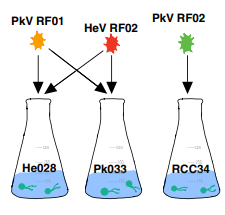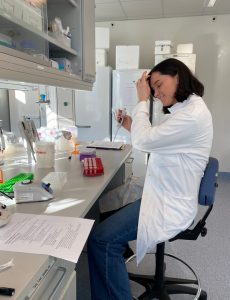As biology is a broad spectre of natural science, I’ve chosen to shed some light towards ecological microbiology, more precise marine ecological microbiology.
Before I talk about the project I participate in, I would like to introduce the people I work with on this project, Ruth-Anne Sandae and Hilde Marie Kristiansen Stabell. They both work at the department of Biological Sciences, and have been involved with this project (that I eventually will introduce), Decay, since 2020.
Infecting sea algae with viruses
One of the algae we have used in our experiments is Haptolina ericina, which is a single cellular organism we use as a host for viruses to infect. Viruses are pathogens for their hosts, which over time, natural selection favours genes in hosts that will make them resistant, but either way, viruses are also affected by selection to overcome host resistance. This makes the virus-host relationship a co-evolving race of defence and counter-defence.
But why algae?
Earth’s surface consists of circa 70 percent water. The biodiversity of the ocean is of a smaller scale compared to the terrestrial, but without the understanding of a wide perspective of organisms, we lack knowledge that helps us understand and maintain healthy ecosystems.
To portray such importance we can view the marine microorganisms, which manufacture roughly 40 percent of the primary production by photosynthesis. One group of microorganisms stands out: The marine phytoplankton, which is the main contributor to the primary production.
As we know, the phytoplankton (algae) obtain their energy from the sun, and as follows, they capture and use the energy, carbon dioxide and water to produce organic compounds. This process is an essential part of maintaining a healthy marine ecosystem, since this cycle partly helps balance life in the ocean.
A possible threat against the algal blooms is infections by viruses. Studying the infectivity of the viruses propagated on the algae and the virus’ ability to survive in the environment (The sea), we can hopefully try answering some questions of how this relationship between pathogen and host evolves throughout the experiment.
Methods for counting virus concentrations and infectivity between pathogen and host
For the last few months our laboratory sessions have consisted of running test tubes containing virus lysate, algae and toxins (plus many other substances). We have pipeted several dilutions series, grown algal cultures, made clonal virus lysate and much more!! In other words, this project has educated me on many laboratory procedures and equipment.
As with all new concepts, practicing is an important part of learning.
Observing and getting input in different distinctive working methods has been essential for my own development of professional identity. In this way, I’ve developed and increased my competence, which has happened through a number of different elements of learning. Among other things, taking part in real research has required me to think like a researcher, and by doing so, formulate scientific questions through observations, read relevant literature and test these scientific questions by preparing hypotheses.
I’ve learned about how to construct a plan for a project and how scientific equipment is to be used in a precise and sensible way. Along the way I have kept a journal, so that the different steps of the project were properly documented, and finally, communicated findings using illustrations and figures in the form of a poster and written a scientific report.
Thanking you for reading my blogpost :))))

